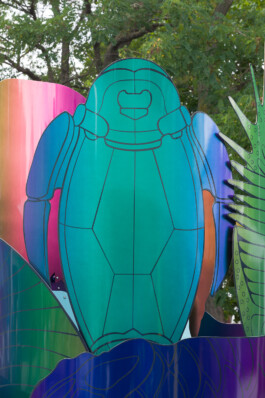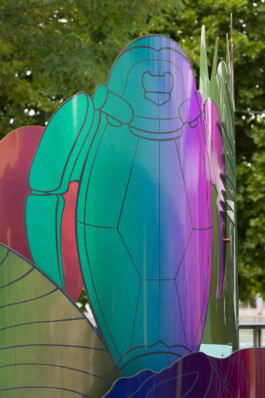








2022, Aluminium sculpture
Devonian
Many of the oil deposits found in the northern hemisphere were formed from the remains of animals, plants and microorganisms that existed during the Devonian period nearly 400 million years ago. Also referred to as The Age of Fish, it is famous for the thousands species of fish that developed during that era, when the land was covered with plants and vertebrates had still not started colonising it. At this time, fish had not developed jaws yet, so their physiognomy was very different than what we usually imagine, with masses of bone covering their outer heads almost like battle helmets. Other crustaceans, shellfish and marine plants also seem completely foreign to us today, as if an alien species landed here from another planet and then suddenly disappeared.
In this project, those beings that we currently use as fuel and plastics via petroleum come alive again as colourful illustrative panels, circularly conjoined together as if to form a single entity. The panels are painted in iridescent oil-like hues, as if to visually time travel to their future anatomy millions of years later.
In essence, the work aims to crystallise the moment that oil was formed, by animating the bodies of its original creators. It also attempts to highlight the fragility of our dependence on fossil fuels, as they flow from biological remains that take millions of years to come into existence.
The word Devonian comes from Devon, England, where the old red sandstone containing these fossils was first studied.
Commissioned by Bagri Foundation and Hayward Gallery









2022, Aluminium sculpture
Devonian
Many of the oil deposits found in the northern hemisphere were formed from the remains of animals, plants and microorganisms that existed during the Devonian period nearly 400 million years ago. Also referred to as The Age of Fish, it is famous for the thousands species of fish that developed during that era, when the land was covered with plants and vertebrates had still not started colonising it. At this time, fish had not developed jaws yet, so their physiognomy was very different than what we usually imagine, with masses of bone covering their outer heads almost like battle helmets. Other crustaceans, shellfish and marine plants also seem completely foreign to us today, as if an alien species landed here from another planet and then suddenly disappeared.
In this project, those beings that we currently use as fuel and plastics via petroleum come alive again as colourful illustrative panels, circularly conjoined together as if to form a single entity. The panels are painted in iridescent oil-like hues, as if to visually time travel to their future anatomy millions of years later.
In essence, the work aims to crystallise the moment that oil was formed, by animating the bodies of its original creators. It also attempts to highlight the fragility of our dependence on fossil fuels, as they flow from biological remains that take millions of years to come into existence.
The word Devonian comes from Devon, England, where the old red sandstone containing these fossils was first studied.
Commissioned by Bagri Foundation and Hayward Gallery